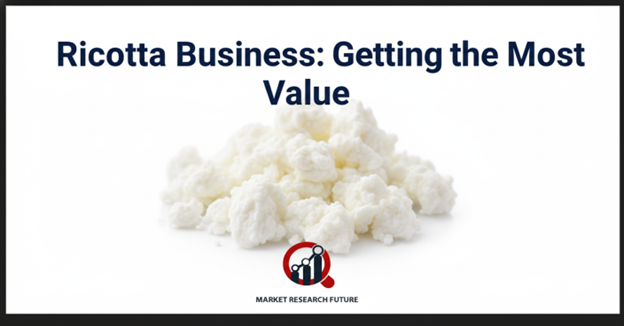Ricotta Business: Getting the Most Value

Ricotta Market Overview
The global ricotta cheese market is gaining prominence as demand for fresh, natural, and protein-rich dairy products continues to rise. Ricotta—a soft, unripened Italian cheese traditionally made from cow’s milk and whey—is celebrated for its creamy texture, mild sweetness, and versatile applications across culinary segments. Once confined to traditional Italian cuisine, ricotta has now become a global favorite, widely used in desserts, pasta dishes, baked goods, and appetizers.
The growing emphasis on healthy eating, high-protein diets, and artisanal dairy products is driving market expansion. As consumer preferences shift toward clean-label and freshly made products, ricotta stands out for its minimal processing and nutritional value. Furthermore, technological advancements in dairy production and packaging are enabling large-scale, consistent, and hygienic ricotta manufacturing, meeting both retail and foodservice demand.
What is Ricotta Cheese?
Ricotta—meaning “recooked” in Italian—is made by reheating whey, a by-product of cheese-making, with milk to extract remaining proteins and form fine, soft curds. The process includes:
- Boiling milk and whey to form curds
- Draining and molding curds in cloth-lined boxes or molds
- Whey drainage for 1–2 hours to achieve desired texture
Ricotta is known for its high moisture content and low acidity, requiring continuous refrigeration to preserve freshness. It is primarily made from cow’s milk, though sheep’s milk ricotta remains popular in southern Italy (Sardinia, Puglia, Sicily).
Varieties include:
- Fresh Ricotta: Soft, slightly sweet, best for desserts and spreads
- Smoked or Aged Ricotta: Firmer texture, stronger flavor for savory dishes
Shifting Global Priorities
Consumer interest is shifting toward natural, protein-rich, and minimally processed foods. The rising adoption of Mediterranean diets, focus on functional foods, and increased awareness of whey protein benefits are fuelling ricotta’s global appeal.
Key factors shaping this trend include:
- Preference for high-protein, low-fat dairy products
- Growth in home cooking and gourmet food trends
- Rising demand for clean-label and artisanal cheese
- Expansion of foodservice and bakery industries
- Increased awareness of sustainable dairy practices utilizing whey
Key Market Growth Drivers
1. Health and Nutrition Trends
Ricotta’s high protein and essential amino acid content—especially from whey protein—supports muscle development and recovery, appealing to fitness-conscious consumers.
2. Culinary Versatility
Its mild flavor makes it ideal for desserts (cheesecakes, cannoli), savory dishes (lasagna, ravioli), and appetizers, enhancing its use across cuisines.
3. Growing Artisanal and Gourmet Market
The rise of premium dairy products and on-site cheese making in restaurants and boutique dairies is boosting ricotta’s popularity among food enthusiasts.
4. Technological Advancements
Modern stainless steel molds, automated drainage systems, and cold chain logistics ensure consistency, hygiene, and extended shelf life, driving industrial-scale production.
5. Whey Utilization and Sustainability
Ricotta production aligns with zero-waste and circular economy practices by reusing whey, a by-product of cheese-making, reducing environmental impact.
Challenges
Despite its growing appeal, the ricotta market faces notable challenges:
- Short Shelf Life: High moisture content limits storage and distribution range
- Refrigeration Needs: Requires continuous cold chain for quality retention
- Regional Preferences: Taste and texture expectations vary by market
- Production Costs: Artisanal methods and small-batch production can be expensive
Regional Insights
Europe
Europe, led by Italy, remains the traditional stronghold of ricotta production and consumption. The region’s emphasis on PDO-certified dairy and artisanal cheese supports premium market growth.
North America
The U.S. market is expanding rapidly with increasing demand for Italian cuisine and high-protein dairy. Supermarkets and delis feature multiple ricotta varieties, while artisanal producers are gaining traction.
Asia-Pacific
Growing urbanization, Western food adoption, and rising disposable incomes are driving demand in Japan, China, and Australia, especially through the foodservice sector.
Latin America & Middle East
Emerging interest in Mediterranean diets and fusion cuisines is fostering gradual ricotta adoption, primarily in urban centers and premium retail outlets.
Key Players
Prominent companies in the global ricotta market include:
- Lactalis Group
- Fonterra Co-operative Group
- Saputo Inc.
- BelGioioso Cheese Inc.
- Arla Foods
- Sorrento Lactalis
- Organic Valley
- Local artisanal and regional producers
These players are focusing on product innovation, organic offerings, sustainable sourcing, and expanded retail networks to strengthen market presence.
Future Outlook
The ricotta cheese market is set for steady growth, driven by health-conscious consumers, premiumization, and the integration of functional proteins in daily diets. Emerging opportunities include:
- Organic and lactose-free ricotta
- High-protein fortified products
- Ready-to-eat (RTE) meal kits and snacks
- Innovative packaging for longer shelf life
- Expansion in developing markets through cold chain investments
Conclusion
Ricotta stands at the intersection of tradition and modern wellness trends, offering both nutritional benefits and culinary versatility. With consumers increasingly seeking natural, protein-rich, and authentic dairy experiences, ricotta’s market potential continues to rise globally.
Investments in cold chain logistics, innovative packaging, and sustainable whey utilization will be key to maximizing value in this segment. As artisanal and industrial producers align with evolving consumer demands, ricotta is poised to remain a staple in both household kitchens and gourmet menus worldwide.

Leave a Comment